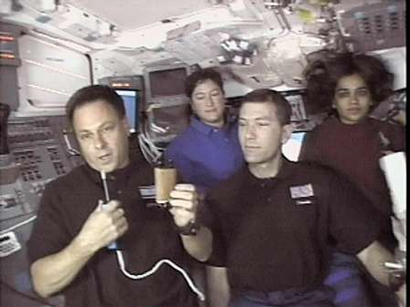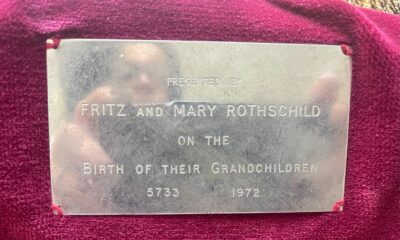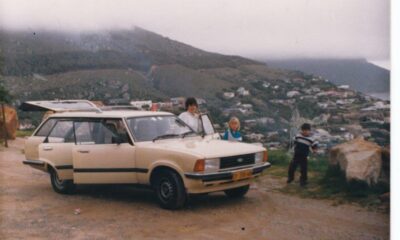
Featured Item

Tiny Torah scroll lost in space makes huge ripples on earth
When Israeli astronaut Ilan Ramon headed into space in 2003, he took with him a miniature Torah scroll which had survived the Holocaust. Tragically, both Ramon and the scroll were lost in a fatal accident upon re-entry into the atmosphere.
However, their spiritual legacy will remain alive for generations to come thanks to a determined South African, Neil Rubinstein, the driving force behind an effort to replicate the lost Torah scroll.
Ramon, an Israeli fighter pilot and later the first Israeli astronaut, was a space shuttle payload specialist of STS-107, the fatal mission in which he and six other crew members were killed in the re-entry accident in February 2003.
From space, Ramon broadcast a message in which he acknowledged the resilience of the Jewish people, something he felt the tiny Torah scroll in his hand captured so well.
“This was given by a rabbi to a scared, thin young boy in Bergen-Belsen,” said Ramon from the space shuttle. “It represents more than anything the ability of the Jewish people to survive. From horrible periods, black days, to reach periods of hope and belief in the future.”
This message resonated deeply with Rubinstein at the time.
“When I first saw this clip many years ago, I had a sense that there was something almost prophetic about Ilan Ramon’s words,” he told the SA Jewish Report from his home in Israel, where he lives today. “He was a completely secular Israeli with no religious background at all, and he chose to share that story with the world in the minute that he had.”
“That was what he felt was most significant to show about the Jewish people.”
Rubinstein explained that NASA had sent Ramon to Israel to be trained by Joachim Joseph, a Professor at Tel Aviv University and a world-renowned scientist. Ramon noticed a little wooden box on the mantlepiece in Joseph’s living room and asked what it was. Joseph was in fact a Holocaust survivor who had been given the Torah after reading his barmitzvah portion from it clandestinely in Bergen Belsen in 1944.
Only 4.5 inches tall, the scroll belonged to Rabbi Simon Dasberg, who passed it on to Joseph on condition that he share its story if he should survive the Holocaust
Says Rubinstein: “Ilan, himself a child of Holocaust survivors, was blown away by the story. He thought it through for a long time, and eventually asked Joseph if he could take the Torah with him into space.”
He continues: “You can’t just take anything on a space mission, and NASA [the National Aeronautics and Space Administration] was very taken aback. He managed to create an aura that so moved NASA that even after the disaster, a non-Jewish astronaut flew up a replica of the Sefer Torah into space in Ramon’s honour. He moved them all.”
Inspired by the story, Rubinstein, a partner in a Swiss asset management company, looked for ways to carry the story forward and use it to uplift others. Rubinstein worked closely with Rabbi Yirmiyahu Abramov, a world leader in Jewish education, and created a non-profit project to connect young Jews with their Jewish heritage and spirituality.
“A lot of work has been done to perpetuate Ramon’s memory in the scientific field,” says Rubinstein. “The Ramon Foundation is doing amazing work in terms of science and space, but we wanted to focus on the spiritual message of the survival of the Jewish people that Ilan Ramon shared with the world.
Eventually, it was decided earlier this year that the ideal tribute would take the form of an exact replica of the Torah scroll, one written according to halacha by a sofer (scribe).
“It’s a real challenge,” admits Rubinstein. “You’re fitting 42 lines into a scroll the size of a mezuzah scroll. No sofer wants to do that – it’s basically micro calligraphy, very expensive and very complicated.”
“Most scribes aren’t prepared to write on a continuous basis, but we found a sofer who has been writing day and night for nine months. It’s tough work.”
Rather than be housed in a museum, the Torah will be used promote the concept of Jewish heroism, perpetuating the spiritual legacy of Ramon and will be used by barmitzvah boys and in various educational programs in Israel.
An accompanying curriculum based on the idea of spiritual heroism is being devised as well, with Ramon featuring as one of the three figures used to convey lessons of bravery within a spiritual context.
“The non-profit is called The Triumph of the Jewish Spirit,” says Rubinstein. “It’s based on the concept of the spiritual fortitude and incredible strength of Jews over the years as a catalyst to ignite each Jew and start their journey.”
He adds: “The Ilan Ramon section of the project is really about trying to educate a barmitzvah boy on the centrality of Torah to a Jewish lifestyle. Many bar mitzvah boys are really disconnected, and we’re hoping to give them a meaningful context through which to connect.”
“Ramon became more connected to his heritage and went from being an Israeli to a Jewish hero. The replica will take his story forward and perpetuate the spiritual legacy which he represented.”
Because the project is not affiliated with any one institution, the Torah will be circulated amongst various educational programs in Jerusalem, including Birthright and other educational heritage groups.
“Many of them have never had a barmitzvah,” explains Rubinstein. “We hope to use the Torah and its story to inspire and challenge youngsters to connect with their own spirituality.”
“It’s a powerful educational tool, and the idea of having them read their parsha from the replica Torah will close the circle and make the occasion even more significant.”
The replica is nearing completion and should be ready in time for Ramon’s 18th yahrzeit, scheduled for early February next year.
“I think it’s an incredible story,” says Rubinstein. “The miraculous survival of the Torah and now this bringing it back to life.
“We’re giving life to this story again as we approach the 18th yahrzeit and celebrate the spiritual legacy of Ilan Ramon, a real spiritual icon.”










